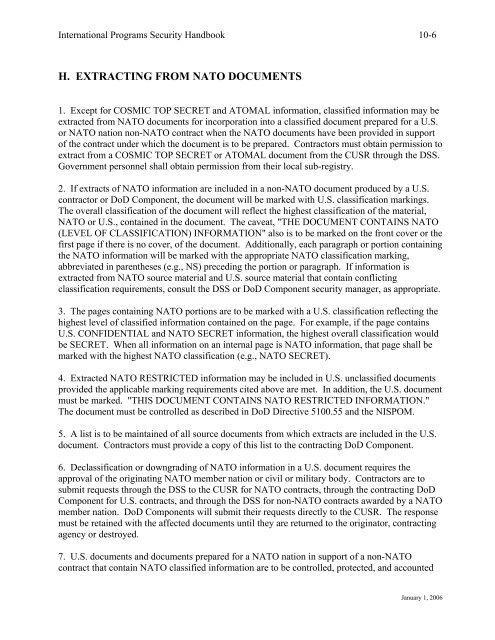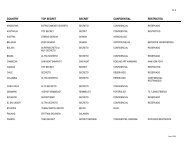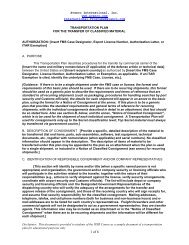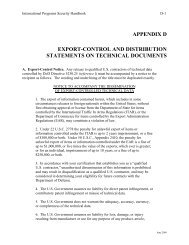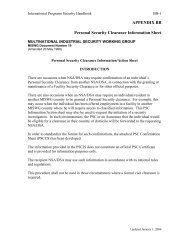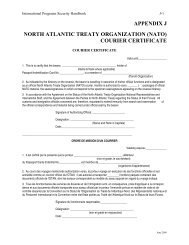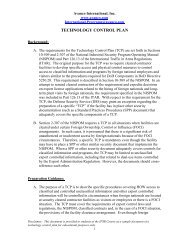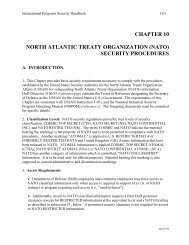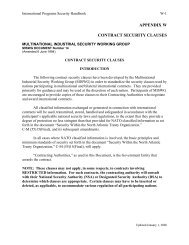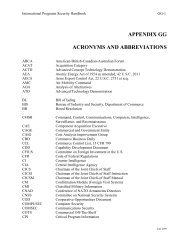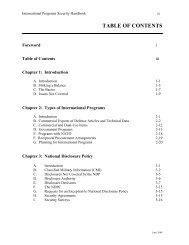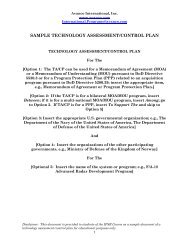chapter 10 north atlantic treaty organization (nato) - Avanco ...
chapter 10 north atlantic treaty organization (nato) - Avanco ...
chapter 10 north atlantic treaty organization (nato) - Avanco ...
Create successful ePaper yourself
Turn your PDF publications into a flip-book with our unique Google optimized e-Paper software.
International Programs Security Handbook <strong>10</strong>-6<br />
H. EXTRACTING FROM NATO DOCUMENTS<br />
1. Except for COSMIC TOP SECRET and ATOMAL information, classified information may be<br />
extracted from NATO documents for incorporation into a classified document prepared for a U.S.<br />
or NATO nation non-NATO contract when the NATO documents have been provided in support<br />
of the contract under which the document is to be prepared. Contractors must obtain permission to<br />
extract from a COSMIC TOP SECRET or ATOMAL document from the CUSR through the DSS.<br />
Government personnel shall obtain permission from their local sub-registry.<br />
2. If extracts of NATO information are included in a non-NATO document produced by a U.S.<br />
contractor or DoD Component, the document will be marked with U.S. classification markings.<br />
The overall classification of the document will reflect the highest classification of the material,<br />
NATO or U.S., contained in the document. The caveat, "THE DOCUMENT CONTAINS NATO<br />
(LEVEL OF CLASSIFICATION) INFORMATION" also is to be marked on the front cover or the<br />
first page if there is no cover, of the document. Additionally, each paragraph or portion containing<br />
the NATO information will be marked with the appropriate NATO classification marking,<br />
abbreviated in parentheses (e.g., NS) preceding the portion or paragraph. If information is<br />
extracted from NATO source material and U.S. source material that contain conflicting<br />
classification requirements, consult the DSS or DoD Component security manager, as appropriate.<br />
3. The pages containing NATO portions are to be marked with a U.S. classification reflecting the<br />
highest level of classified information contained on the page. For example, if the page contains<br />
U.S. CONFIDENTIAL and NATO SECRET information, the highest overall classification would<br />
be SECRET. When all information on an internal page is NATO information, that page shall be<br />
marked with the highest NATO classification (e.g., NATO SECRET).<br />
4. Extracted NATO RESTRICTED information may be included in U.S. unclassified documents<br />
provided the applicable marking requirements cited above are met. In addition, the U.S. document<br />
must be marked. "THIS DOCUMENT CONTAINS NATO RESTRICTED INFORMATION."<br />
The document must be controlled as described in DoD Directive 5<strong>10</strong>0.55 and the NISPOM.<br />
5. A list is to be maintained of all source documents from which extracts are included in the U.S.<br />
document. Contractors must provide a copy of this list to the contracting DoD Component.<br />
6. Declassification or downgrading of NATO information in a U.S. document requires the<br />
approval of the originating NATO member nation or civil or military body. Contractors are to<br />
submit requests through the DSS to the CUSR for NATO contracts, through the contracting DoD<br />
Component for U.S. contracts, and through the DSS for non-NATO contracts awarded by a NATO<br />
member nation. DoD Components will submit their requests directly to the CUSR. The response<br />
must be retained with the affected documents until they are returned to the origi<strong>nato</strong>r, contracting<br />
agency or destroyed.<br />
7. U.S. documents and documents prepared for a NATO nation in support of a non-NATO<br />
contract that contain NATO classified information are to be controlled, protected, and accounted<br />
January 1, 2006


